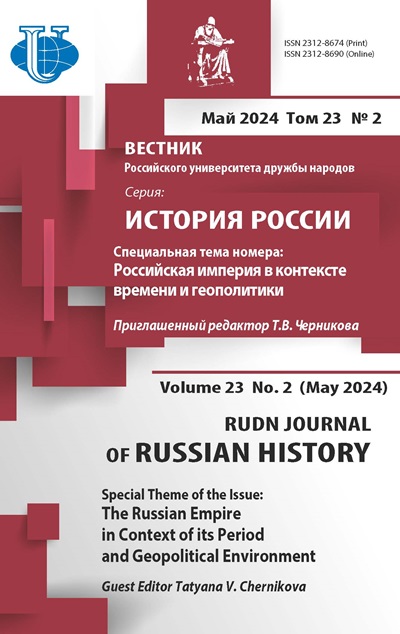ЖЕНЩИНЫ И ЖЕНСКИЙ БЫТ В СССР 1950-1960-Х ГГ. В СОВЕТСКОЙ И СОВРЕМЕННОЙ РОССИЙСКОЙ ИСТОРИОГРАФИИ
- Авторы: Рябкова ЕС1
-
Учреждения:
- Институт этнологии и антропологии РАН имени Н.Н. Миклухо-Маклая
- Выпуск: Том 16, № 4 (2017)
- Страницы: 670-685
- Раздел: СТАТЬИ
- URL: https://journals.rudn.ru/russian-history/article/view/17465
- DOI: https://doi.org/10.22363/2312-8674-2017-16-4-670-685
Цитировать
Полный текст
Аннотация
Актуальность обращения к историографии вопроса повседневности советских женщин в период «оттепели» объясняется сохранением послевоенного образа женщины - матери, жены и труженицы - и в настоящее время. Поэтому изучение этого многоролевого образа имеет не только научную, но и практическую значимость. В данной статье рассматриваются взгляды советских и современных отечественных историков на бытовые практики советских горожанок. Авторы, находясь в разных идеологических условиях, пытались реконструировать историю советских женщин и их быт, применяя различные подходы к исследованию. Данный историографический обзор дает возможность определить периодизацию изучения, а также выявить общее и особенное в восприятии исследователями быта советской женщины.
Об авторах
Е С Рябкова
Институт этнологии и антропологии РАН имени Н.Н. Миклухо-Маклая
Автор, ответственный за переписку.
Email: katerinapositiv@gmail.com
Рябкова Екатерина Сергеевна - аспирант Института этнологии и антропологии РАН им. Н.Н. Миклухо-Маклая (Москва, РФ).
119334 Россия, Москва, Ленинский проспект, 32АСписок литературы
- Большая советская энциклопедия. Том. 3. М.: Наука, 1970.
- Араловец H.Д. Женский труд в промышленности СССР. М.: Профиздат, 1954.
- Абрамова А.А. Охрана трудовых прав женщин в СССР. М.: Госюриздат, 1954.
- Бильшай В.Л. Решение женского вопроса в СССР. М.: Госполитиздат, 1959.
- Овсянникова М.Д. Факты и цифры о положении женщин в СССР. М., 1954.
- Ус А.П. Что дала советская власть женщинам. Минск: Госизд БССР, 1950.
- Зуева Т.II. Роль советских женщин в развитии науки, культуры и искусства. М.: Профиздат, 1956.
- Куприн О. Быт - не частное дело. М.: Профиздат, 1959. С. 77-78.
- Матвеев Д.С. Дочь завода. Оренбург: Оренбургское кн. изд-во, 1962.
- Горбачев А.Б. Девушка из России. Оренбург: Оренбургское кн. изд-во, 1962.
- Овчинникова И.Н. Советские женщины активные строители коммунизма. Л.: Лениздат, 1961.
- Белоглазова Г.В. , Савинова Л.Н. Советская женщина - активная участница коммунистического строительства. М., 1977. С. 4-5.
- Гордон Л.А., Римашевская Н.М. Пятидневная рабочая неделя и свободное время трудящихся. М. : Мысль, 1972.
- Грушин Б.А. Свободное время: Актуальные проблемы. М.: Мысль, 1967.
- Гордон А., Возьмитель А., Журавлева И., Клопов Э., Римашевская Н., Ядов В. Социология быта, здоровья и образа жизни населения // Социология в России. М.: Изд-во РАН , 1998. С. 438-445.
- ООН и женщины // Объединение Объединенных Наций. URL: http://www.un.org/ru/ sections/issues-depth/women/index.html (Дата обращения 12.07.2017).
- Чуманенко В.Г. Положение женщины при капитализме. М.: Профиздат, 1975.
- Белова В.С. Положение женщин в СССР. М.: Профиздат, 1975.
- Зуйкова Е.М., Плаксина Н.Н. Решение женского вопроса в СССР и его международное значение. М.: Профиздат, 1976.
- Новикова Э.Е., Языкова В.С., Янкова З.А. Женщина. Труд. Семья. М.: Профиздат, 1977.
- Гордон Л., Клопов Э., Оников Л. Социальные проблемы быта // Коммунист. 1974. № 17. С. 49-60.
- Новикова Э.Е., Сидорова Т.Н., Турчанинова С.Я. Советские женщины и профсоюзы. М.: Профиздат, 1984.
- Крылова З.П. Советская женщина: труд, материнство , семья. М.: 1987.
- Костаков В. Женская работа // Крылова З.П., Акивис Д.С., Костыгова Т.М., Журавская И.А. Советская женщина: труд, материнство, семья. М.: 1987. С. 48-49.
- Айвазова С. Идейные истоки женского движения в России // Общественные науки и современность. 1991. № 4. С. 20-25.
- Панкратова М.Г. Русская женщина сегодня // Женщины России вчера, сегодня, завтра. М., 1994. С. 12-24.
- Козлова Н. H. Советская представительная система: к вопросу участия женщин в деятельности местных органов власти // Женщины в социальной истории России: сб. науч. тр. Тверь : Издательство ТГУ. 1997. С. 12-20.
- Хасбулатова О.А. Этапы российской государственной политики по вовлечению женщин в сферу государственного управления (1990-1999 гг.) // Женщина в Российском обществе. 1999. № 3. С. 33-42.
- Петров М.С. Эволюция образа работающей женщины в отечественной журналистике (по материалам журнала «Крестьянка») // Труд и социальные отношения. № 5. 2010. С. 47-49.
- Гамелько Е.В. Образ советской женщины на страницах журнала «Работница» // Молодой ученый. 2009. С. 174-177.
- Смеюха В.В. Процессы идентификации и женская пресса. Ростов-на-Дону, 2012. С. 58-59.
- Шабатура Е.А. Образ советской женщины в журналах «Коммунистка» и «Красная сибирячка» // Адам и Ева. Альманах гендерной истории. № 8. Москва, 2004. С. 138-149.
- Дашкова Т. Идеология в лицах. Формирование визуального канона в советских женских журналах 1920-х - 1930-х гг. // Культура и власть в условиях коммуникационных революций 20 века. Форум немецких и российских исследователей / Под ред. К. Аймермахера, Т.Бордюгова, И. Грабовского. М., 2005. С. 139-145.
- Усманова А. «Визуальный поворот» и гендерная история // Гендерные истории Восточной Европы. Минск: ЕГУ, 2002. С. 36-57.
- Хасбулатова О. Российская гендерная политика в 20-м столетии: мифы и реалии. Иваново: Иван. гос. унив-т, 2005. С. 254-255.
- Градскова Ю. Дискурс «социального материнства» и повседневные практики в 1930-е - 1950-е годы // Нужда и порядок: история социальной работы в России в 20 веке. М.: Саратов, 2005. С. 304-315.
- Чернова Ж. Семейная политика в Европе и в России: гендерный анализ. СПб.: Норма, 2008. С. 110-115.
- Григорьева А.Г. Советская повседневность и уровень жизни населения СССР в 1953-1964 гг. Автореферат канд. диссертации. М.: Издательство МГУ, 2003. С. 5-6.
- Лебина Н.Б., Чистиков А.Н. Обыватель и реформы. Картины повседневной жизни горожан в годы нэпа и хрущевского десятилетия. СПб., 2003.
- Пушкарева Н.Л. Гендерная система в России 20 века и судьбы россиянок // Новое литературное обозрение. Вып. 117. Москва, 2012. № 5. С. 8-24.
- Белова А.В. Женская повседневность как предмет этнологического изучения // Этнографическое обозрение. М.: Издательство ИЭА РАН , 2004. № 4. С. 86-95.
- Виниченко И.В. Советская повседневность 50-х - середины 60-х гг. XX века: женский костюм в моделях одежды и бытовой практике. Автореферат канд. диссертации. Омск: Издательство Омского государственного университета, 2009. С. 4-5.
















